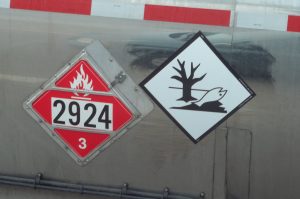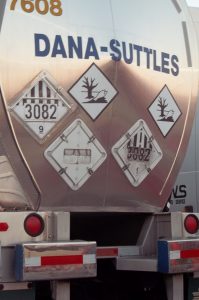A question. December 5, 2017:
Good afternoon, I’m looking for some clarification on class 9 hazmat material.
One of our customers, their product is considered a class 9 Marine Pollutant, we have always been instructed that this only needed to be classified as a pollutant if going over international waters. All I can find online is that it does not need to be placard, only marked and identified on the BOL. My question is when getting quotes from or LTL carriers do we need to be getting this quoted as hazmat material, or can we quote as normal material since we do not cross any bodies of water, except rivers.
Reading through your sight has cleared a lot of things up, one question I do have is on the Bulk. Our customers packaged: 1) plastic bag, then in a box. 2) in a box. Most boxes are packaged at 25kg. then shipments are pallatized, boxes per pallet range from 5-40 boxes (100 kg to 1000 kg). Since each form of the product is boxed in 25kg packages is this considered bulk even though it is not all “together”
Contact me with any questions you may have about the transportation of hazardous materials by air, highway, vessel, or rail International and Domestic Daniels Training Services, Inc. 815.821.1550 |
My reply that same day:
Thank you for contacting me. I will try to answer your question below.
- Per USDOT regulations a marine pollutant must meet three criteria (read: What is a Marine Pollutant?):
- ID’d by name in table of marine pollutants. Found in Appendix B to the Hazardous Materials Table at 49 CFR 172.101.
- Above concentration threshold: 10% or more for a marine pollutant, 1% or more for a severe marine pollutant.
- Transported by vessel or in a bulk packaging. Read: Bulk Packaging for HazMat Explained! Therefore, even if transported by highway or rail, it is possible to have a marine pollutant if it is in a bulk packaging.
- If classified as a marine pollutant and it does not meet the criteria of any other hazard class it must be classified as a Class 9 Miscellaneous. All other HazMat regulations apply but a Class 9 is not required to display the Class 9 Miscellaneous placard on the vehicle. Read: Is the Class 9 Placard Required?
- Since a Class 9 does not require the display of a placard, the driver of the motor vehicle transporting it does not require the HazMat endorsement on the CDL. However, it is still regulated as a hazardous material which means the driver – and all others involved in its transportation – must have HazMat Employee training (I provide this training).
- What you describe (“…1) plastic bag, then in a box. 2) in a box.”) is not a bulk packaging. It is an overpack, which is subject to its own regulations.




 not impact display of the Marine Pollutant marking.
not impact display of the Marine Pollutant marking. And a post from someone else in the group that same day as well:
And a post from someone else in the group that same day as well: